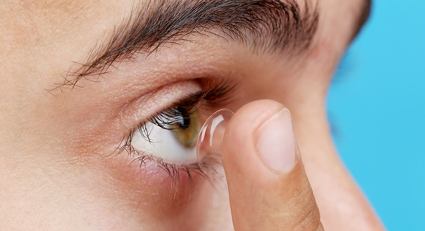No. of views : (7593)
Most common side effects of using contact lens
Posted on: 05/Jul/2019 5:06:02 PM

Contact lenses fall under medical device category. These are under the regulation of U.S. Food and Drug Administration. People assume contact lenses to be advantageous than regular specs and hence choose them. Basically, these contact lenses will get adjusted to the total amount of light your eyes receive. As they precisely fit into your eyes, there is no hindrance in the peripheral vision. And the user need not worry about breakage of specs.
On the contrary, there is also the down side of contact lens. This article will articulate these disadvantages and side effects of contact lenses.
Dry eyes :
This is the very first effect of contact lenses. Most of the contact lens users tend to experience dry eye issues. As they wear lens, the total amount of tears produced will get reduced and this in turn will bring down oxygen delivered to cornea. This will lead to itchy eyes or stinging eyes plus irritated cornea and nearby tissues.
Red eye :
Red eye is the result of extensive use of contact lens i.e. prolonged use of contact lens, particularly through night. As you use the lens for such long hours, it will pave way for microorganisms to breed. There are also other cases of red eye occurrence which are the use of deformed lens, deposits on lens which gives rise to irritation and lens that are poor fitting.
Corneal ulcer :
One more side effect of the use of contact lens is the cause of corneal ulcer. This is a result of bacterial contamination taking place on the soft contact lens due to surface deposits. This will multiply at very fast speed. With time, it will lead to bacterial biofilm that delivers infectious agents in the cornea.
Corneal abrasion :
When the contact lens gets scratched with the cornea, it leads to corneal abrasion. In case the lens is not properly fitted, corneal abrasion occurs. When you sleep along with your lens, there will be high chance of corneal abrasion. As the lens gets accumulated with dirt or bacteria, while rubbing against cornea, this may cause infections in the eye.
Superficial Keratitis :
This is the condition where the outermost region of cornea feels irritated. This is a result of using lens care solution or other kinds of infection or mechanical irritation.
Corneal molding :
Corneal molding or simply molding is where the cornea gets its shape changed. This is due the use of contact lens. This often occurs as a result of oxygen deprivation and there are bubbles forming under the lens with lesser pressure. This is quite similar to the cases experienced while traveling in flight in very high altitudes.
Disrupted flow of oxygen to the eyes :
In the cornea, blood vessels are present only in the edges and nowhere else. When there is not sufficient oxygen present, there is stress experienced by the cornea’s metabolism and it results in buildup of lactic acid which leads to an osmotic load. So, there is more water drawn into the cornea than removal quantity. This results in corneal swelling also called oedema. The oxygen delivered on the cornea depends on the lens thickness and the type of material used.
Giant papillary conjunctivitis :
This is a case that often occurs among those who use soft contact lens, particularly those who use the lens for long hours. High mucous production and slightly blurred vision are some of the symptoms of the condition.
Infiltrates :
In the middle of cornea, there will be slight grey areas. This is a result of prolonged use of contact lens or improper fitting of the contact lens or improper care routine for the lens.







